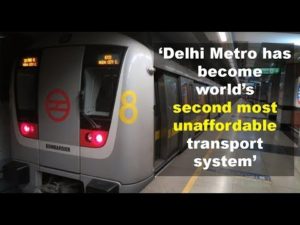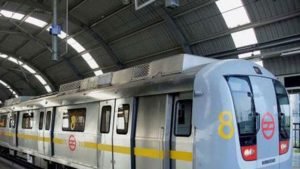As per a new study by Centre for Science and Environment (CSE), Delhi metro is the second most unaffordable transport in the world. They charge less than half US Dollar. Delhi is known for its metro system and such a news is one devastating for the nation. CSE got its data from UBS report based on Price and Earning, 2018.
The study found that the hike in prices of the fare led the Delhiites to spend about 14% of their total income on Metrol travel. This stands just below Hanoi where people spend 25% of their income on metro travel. About 30% of the commuters, spend more than 19.5% of their total income on Metro rides.
CSE’s study also showed that about 46% of the commuters stopped using the transportation means after the fare hike. There is a significant difference between the commuters. It was 39.5 lakh two years back but now stands at just 27 lakhs.
Also Read: The Pink Metro Line
 Most Unaffordable Transport: The concerned officials
Most Unaffordable Transport: The concerned officials
Anumita Roy Chowdhury of CSE at a conclave on ‘Towards clean and low Carbon Mobility’ on Tuesday said that the sudden increase in the metro fares since 2017 has become a major matter of debate among people. She said, “Should metros seeks to meet their future costs of loan repayment and other fixed (depreciation etc) from fares? Or should they look at other financing methods and non fare revenue? This is not just about Delhi Metro but about a cohesive policy for all metros”.
Talking of the fare hike she said that the fare revenues by DMRC were sufficient to meet the requirements by 2016-17. Despite that the Fourth Fare Fixation Committee took that matter of revenue and expenses in order to bring validation for fake hire. She added that they were determining the gap between earning and operating expenses of future. But, they did not take into consideration the non-fare revenue.
The report by CSE which is yet to be published shows that the monthly income of 30% of Delhi metro commuters is RS 20,000. The hike in fares mean they need to spend 19.5% of income on transportation. As per CSE the limit of spending on transportation globally should be affordable as 15% of the total income. The bottom line should be of 20% where not more than 10% should be spent on transportation. In Delhi, 34% of the people cannot afford the services by non-AC buses.
Most Unaffordable Transport: The statement by transport officials of Delhi
The transport commissioner of Delhi, Varsha Joshi was also a part of the conclave. She justified the fare hike and added, “If you don’t increase fares, the quality falls” and provided an example of Metro feeder buses and compared them to that of Metro experience. She added that most people don’t consider using it as a means of transportation because of damaged conditions. With the hike in Metro fares, the fares of Feeder buses have not been increased. She added, “Feeder buses should be as comfortable as the Metro.”
 She further added that Delhi metro fares must be an indexed and graded system’s part so that politics could not interfere with it.
She further added that Delhi metro fares must be an indexed and graded system’s part so that politics could not interfere with it.
Talking about the metro system, Joshi said that the network is extensive and is in need for the improvement of last mile connectivity. She added that the Delhi government had been working to improve it.
Varsha also raised her opinion on people switching from private to public transport. She added, “Car commuters need to be pushed off the road and into Metro or buses.”
Further adding to her statement she said,
“The Delhi government is augmenting transport infrastructure through land pooling in some areas. It is also considering using paratransit for last mile connectivity. While the government is planning to acquire 3000 buses, there is a need to improve his shelters and ancillary infrastructure.”
Most Unaffordable Transport: Public or Private Transport?
Director general of CSE, Sunita Narain added that motorisation has been is increasing in India leading to too much of carbon and pollution. She said, “Growing dependence on personal vehicles for urban commute can lead to irreversible trends and damages.” She further added, “Greenhouse gas emissions from transport, the third highest among all sectors, has recorded the steepest increase. This is also responsible for health-damaging toxic exposure.”
Ashish Verma, the associate professor of Indian Institute of Science in Bangalore also reflected his views. He said that in order to make people move from personal to public transport, the system needs to become more reliable and attractive. This would help in improving the door to door mobility and also increase the customers.




















